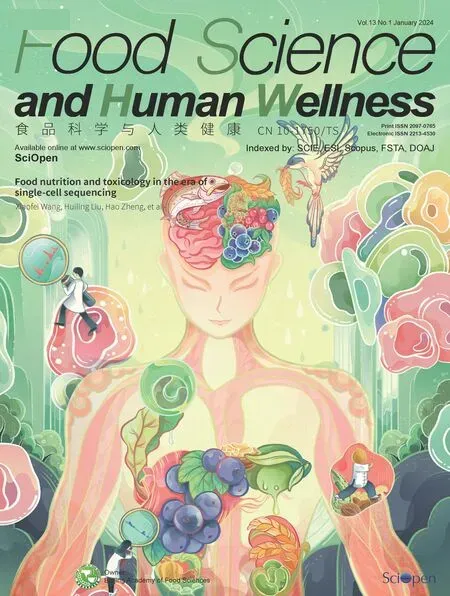Higher intakes of lysine,threonine and valine are inversely associated with non-alcoholic fatty liver disease risk: a community-based case-control study in the Chinese elderly
Xueqi Li,Wenjun M,Ting Yng,Chong Wng,Wei Zhng,Hui Li,Ting Zho,Xiofei Guo,*
a Institute of Nutrition &Health,School of Public Health,Qingdao University,Qingdao 260071,China
b Affiliated Hospital of Qingdao University,Qingdao 260071,China
Keywords:Amino acid Non-alcoholic fatty liver disease Senior citizen Dose-response analysis
ABSTRACT The associations of individual amino acid with non-alcoholic fatty liver disease (NAFLD) risk remained unclear.The present study aimed to investigate the associations between the two in the Chinese elderly.Methods:A community-based health check-up program was conducted in Qingdao,China.NAFLD was diagnosed by ultrasonography accompanied by epidemiological investigation.The dietary intakes of amino acids were investigated with 3-day,24-h dietary records and calculated by Nutrition Calculator software.Restricted cubic spline model was used to evaluate a nonlinear relationship between amino acid intake and NAFLD risk.Results:400 NAFLD subjects were identified,and 400 participants were randomly selected as controls and matched by gender and age (± 3 years) Dose-response analysis showed that 1 000 mg increment of aromatic amino acids (AAAs) was associated with reduced 16% risk of NAFLD.Dietary increments of 750 mg/d threonine,950 mg/d valine,or 1 700 mg/d lysine were associated with a 20% reduction in the NAFLD risk (all P for linearity <0.05).Conclusion:The present study demonstrated that the dietary increases in milk,eggs and deep-sea fish,which are rich in the amino acids,might contribute to protecting against NAFLD in the elderly.
1. Introduction
As a chronic multisystem disease,non-alcoholic fatty liver disease(NAFLD) is influenced by genes,environment,gut microbiota and metabolic factors[1-3].According to the disease progress,it includes simple steatosis,nonalcoholic steatohepatitis (NASH),fibrosis,cirrhosis and hepatocellular carcinoma[4,5].With the changes in lifestyles and dietary patterns,the prevalence of NAFLD affects onequarter of the population around the world[6].Mounting evidence demonstrated that NAFLD subjects are at higher risk of developing serious metabolic-related diseases[7],as people with NAFLD frequently coexist with insulin resistance (IR) related diseases such as abnormal glucose tolerance,lipid metabolism disorder and hypertension[8,9].Thus,it is a crucial public health problem in the prevention and management of NAFLD[10].
To date,there was no globally recognized pharmacotherapy for NAFLD[11].According to a meta-analysis,unhealthy diets and lifestyles were considered as vital factors in aggravating metabolic related diseases[12].The degeneration of basic metabolism,poor absorption,unscientific diet and less exercise contributed to an increased risk of NAFLD[13,14].Consequently,dietary intervention,weight reduction and physical exercise are regarded as the fundamental strategies for therapeutic treatment of NAFLD[15].
Previous studies have shown that proteins could regulate metabolism[16,17].However,protein synthesis was impaired with age,causing a variety of metabolic diseases[18].In addition,protein intake was strongly associated with skeletal muscle and studies have shown that trunk muscle mass index and leg skeletal muscle mass index were negatively associated with the risk of NAFLD[19].Meanwhile,a higher intake of protein was associated with reduced risk of NAFLD[20,21],especially essential amino acids[22,23].Moreover,lower intakes of branched chain amino acids (BCAAs) and higher aromatic amino acids (AAAs) favor the accumulation of liver fat in the early clinical stage[24].In addition,it was reported that BCAAs regulated blood glucose metabolism and insulin secretion was found to recover after BCAAs supplementation[25].Besides,higher levels of AAAs were observed coexisting with metabolic related diseases in individuals[26].Substantial research has investigated the association between dietary intakes of BCAAs,AAAs,essential amino acids and NAFLD risk.However,the association of individual amino with NAFLD risk remained unclear.Therefore,the aim of the present study was to investigate which individual amino acid might be associated with reduced NAFLD risk using a community-based case-control study.
2. Methods
2.1 Study design and population
The participants,aged over 65 years,attended a routine health check-up program in Qingdao (Fushan and Ningxia Community),China.Of these,1 328 individuals (579 males and 749 females)participated in a health examination between March and November,2020.After excluding participants with missing data (n=190) and unreliable 3-day 24-hour food records (n=17),1 121 participants with complete dietary survey and physical examination records were included in the study.Of these,471 cases diagnosed as NAFLD were available for data analysis (male 148,female 323).Participants who met the following exclusion criteria were identified as NAFLD cases:(1) malignancy or a history of malignancy,dementia,organ failure and so on;(2) specific diseases that could lead to steatosis,such as viral hepatitis,drug induced liver disease,total parenteral nutrition,Wilson’s disease and autoimmune liver disease;(3) missing data on abdominal ultrasonography;(4) weekly alcohol consumption was ≥ 140 g for males and ≥ 70 g for females,or excessive alcohol consumption in the previous 12 months[19,27].400 participants were randomly selected as case group and 400 participants were matched as controls with age (± 3 years) and gender.Written informed consent was obtained from all participants,and this study was approved by the Ethics Committee of the Affiliated Hospital of Qingdao University(QYFYWZLL25549).Accordingly,3-day 24-hour dietary records,medical history and lifestyles,anthropometrical measurements and fasting blood samples were collected,respectively.
2.2 Questionnaire interview
As for the dietary survey,3-day 24-hour dietary records (2 working days and 1 weekend) were collected for each participant.Besides,a standard questionnaire was administrated to collect demographics,medical history and lifestyles with a face-to-face interview.The Nutrition system of Traditional Chinese Medicine Combining with Western Medicine (NCCWMX2/NCCW12.0) and Nutrition Calculator software were adopted to assess the dietary intakes of nutrients,including energy intake (kcal),carbohydrate intake (g),fat intake (g),protein intake (g),vitamin intake (mg)and amino acid intake (mg).All investigators and dietary recorders received professional guidance and training before an investigation and dietary analysis.
2.3 NAFLD diagnosis
The diagnostic criteria for fatty liver were based on abdominal ultrasonography and echo patterns,including diffuse echogenicity of the liver and increased echogenicity compared to the renal cortex.Additionally,no excessive alcohol consumption (<140 g/week for male and <70 g/week for female,respectively) with sonographic fatty liver was considered as having NAFLD[27].
2.4 Anthropometrical measurements
Anthropometric parameters were measured using standard routine procedures,including height (m),weight (kg),waist circumference(cm),hip circumference (cm),blood pressure (mmHg).Body mass index (BMI) was calculated as weight (kg) divided by the square of height (m2).
2.5 Biochemical measurement
The fasting blood samples were collected,and the serum was obtained by centrifugation at 3 500 r/min for 10 min at 4 °C.The levels of fasting blood glucose (FBG),total cholesterol (TC),triglyceride (TG),high-density lipoprotein cholesterol (HDL-C),low-density lipoprotein cholesterol (LDL-C) were measured by an automatic biochemical analyzer (Accute TBA-40FR autoanalyser,Toshiba,Japan) at the Affiliated Hospital of Qingdao University.
2.6 Statistical analysis
The Shapiro-Wilk test was applied to check the normality of continuous variables.Normally distributed data were expressed as the mean ± standard deviation (SD),and skewed data were presented as medians (inter-quartile range).The category variables were expressed as percentages.The characteristics of the participants were compared with Student’st-test for normally distributed continuous variables,while skewed continuous variables were compared with the Wilcoxon rank-sum test.Besides,the Chi-test was conducted for categorical variables.
The intakes of daily protein,carbohydrate,fat,amino acids and vitamins were categorized by quartiles based on the distribution of daily intake (Q1-Q4).The multivariate-adjusted odds ratio (OR) and the corresponding 95% confidence interval (CI) of the conditional binary logistic regression model were used to estimate the associations of amino acid intake and NAFLD risk with adjustment for age,waisthip ratio (WHR),FBG,smoking,TC,total energy intake,LDL-C and HDL-C.Besides,we tried to adjust for confounding factors such as BMI,alcohol consumption,education levels and TG,and found no significant difference between case and control groups.Restricted cubic spline models were used to evaluate a nonlinear relationship between amino acid intake and NAFLD risk.If a non-significant nonlinear association was found,a linear dose-response analysis was performed for trend estimation.All statistical analyses were conducted using Stata 15.0.A two-tailedP<0.05 was considered as a significant difference.
3. Results
The characteristics of the participants are presented in Table 1.A total of 800 subjects were involved in this study.The proportions of participants overweight or obesity were significantly higher in the cases compared with the matched controls (P<0.001).Accordingly,waist circumference,hip circumference and WHR were significantly higher in cases compared with controls (P<0.001 for all).Besides,there were significantly higher FBG and TG levels in the cases compared with the controls (P<0.001).Besides,there were nonsignificant differences between groups with respect to age,gender,height,TC,HDL-C,LDL-C,vitamin intakes,protein and amino acid intakes,in our study (Tables S1 and S2).
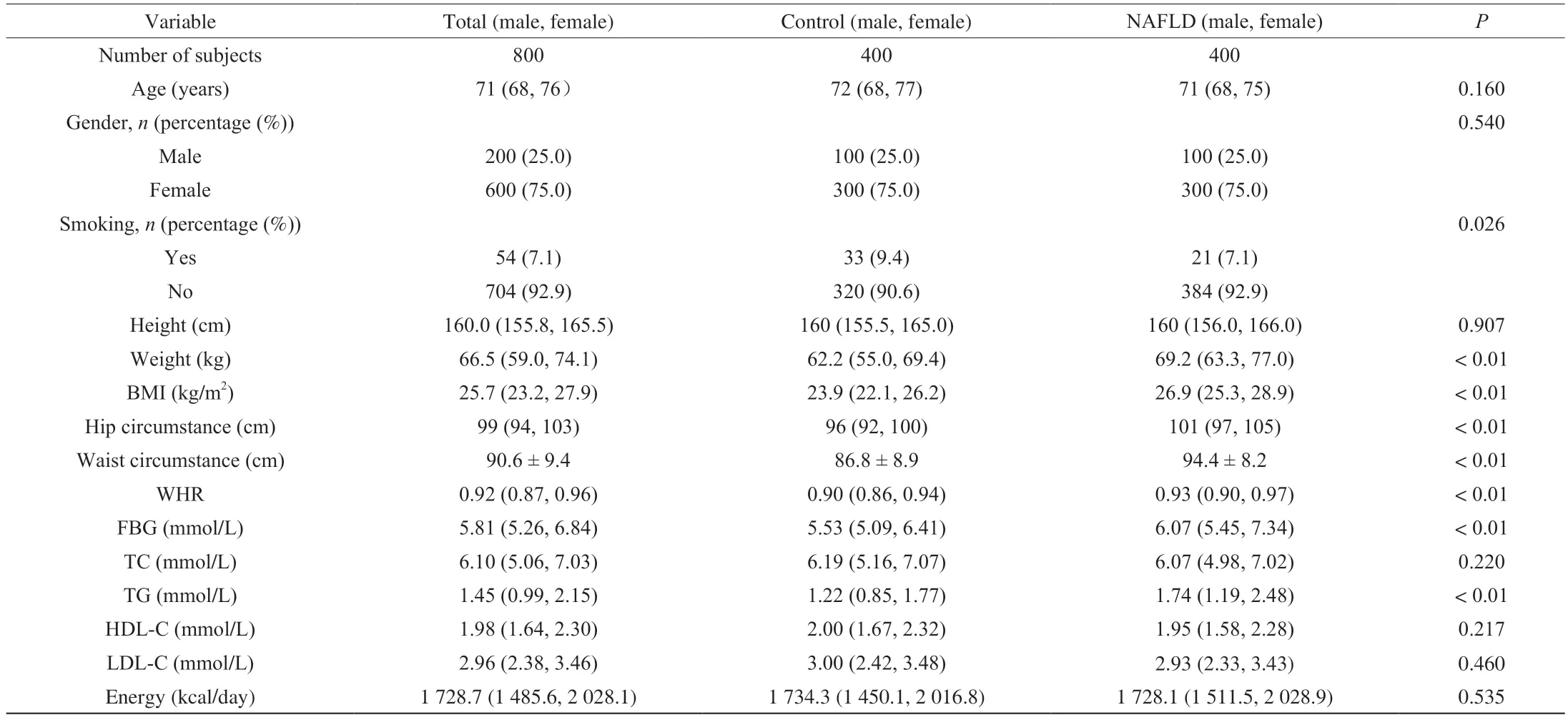
Table 1 Characteristics of the subjects according to NAFLD.
After adjusting for potential confounders factors,higher intakes of lysine (OR=0.55;95% CI: 0.32,0.97),threonine (OR=0.57;95%CI: 0.32,0.97),valine (OR=0.55;95% CI: 0.32,0.96) and AAAs(OR=0.52;95% CI: 0.29,0.93) were associated with a lower risk of NAFLD (allPfor trend <0.05) (Fig.1).In addition,higher intakes of histidine (OR=0.62;95% CI: 0.35,1.09,Pfor trend <0.05),isoleucine (OR=0.60;95% CI: 0.34,1.03;Pfor trend <0.05),and BCAAs (OR=0.59;95% CI: 0.34,1.04;Pfor trend=0.055) were marginally associated with NAFLD risk in the multivariable-adjusted model (Fig.S1).Besides,the third quartile of total protein intakes was associated with a lower NAFLD risk (OR=0.46;95% CI: 0.25,0.84,Pfor trend <0.05).
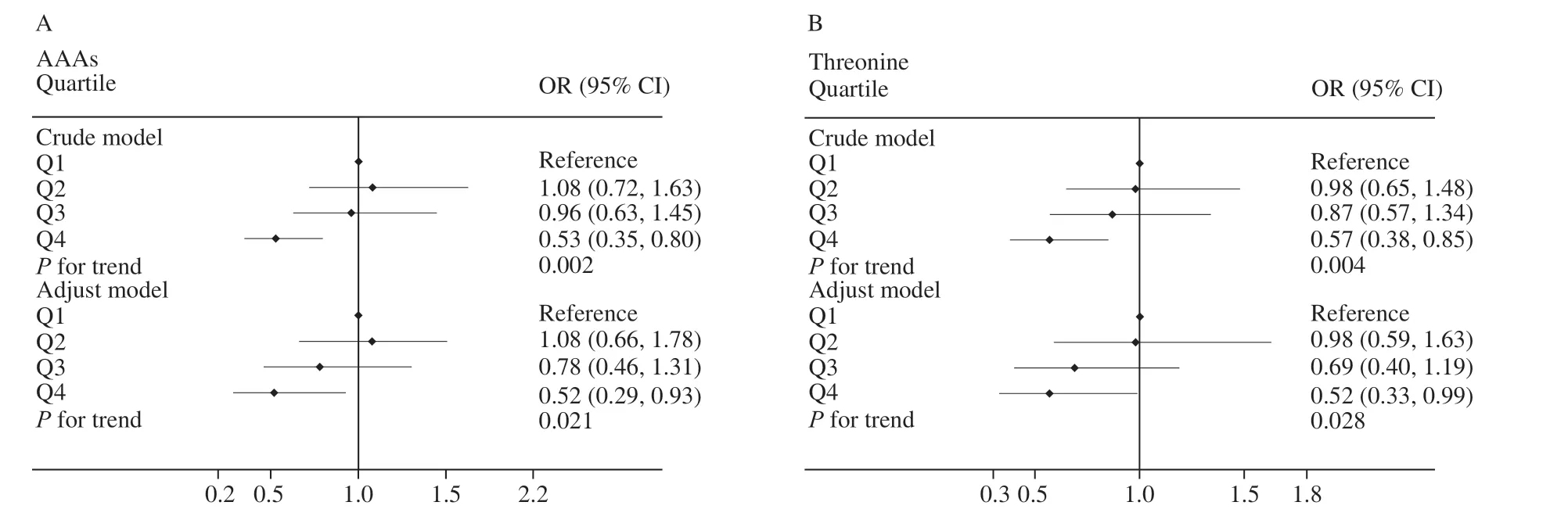
Fig.1 Forest plot to quantify the association between the intakes of AAAs (A),threonine (B),valine (C),lysine (D) and NAFLD risk.AAAs: aromatic amino acids.
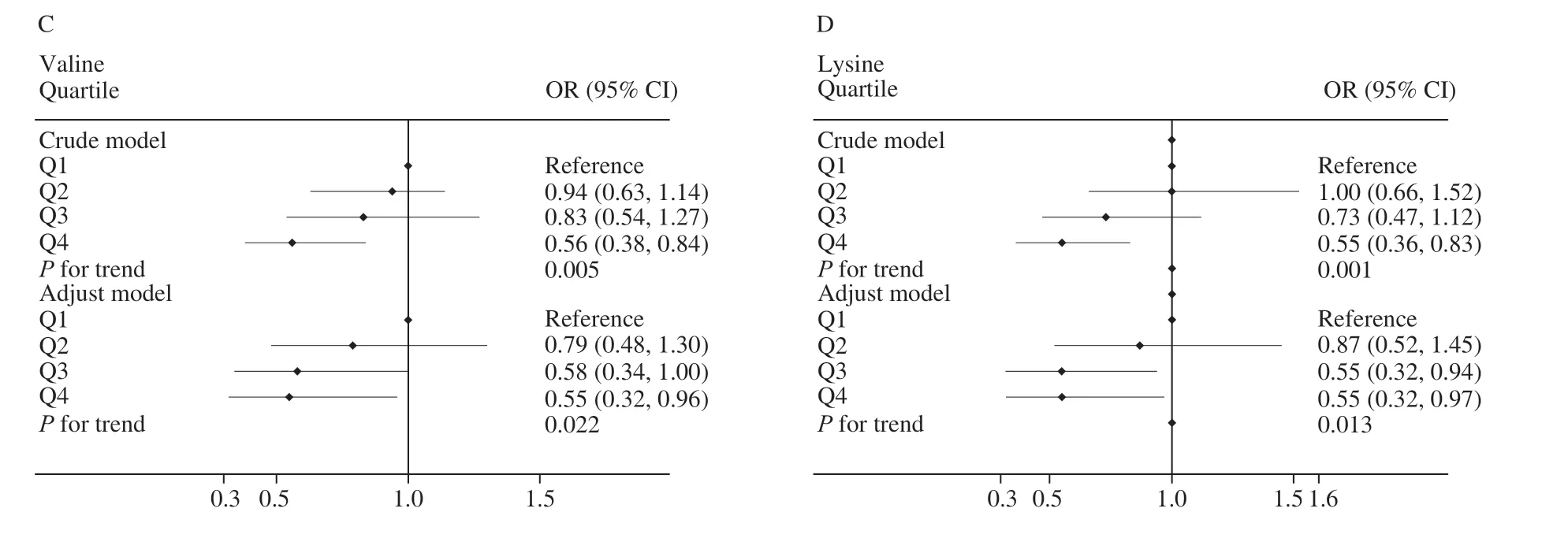
Fig.1 (Continued)
Dose-response analysis showed that 1 000 mg/d increment of AAAs was associated with a 16% reduction of NAFLD risk(OR=0.84;95% CI: 0.73,0.96;Pfor linearity=0.008).Additionally,750 mg/d increment of threonine (OR=0.80;95% CI: 0.66,0.97;Pfor linearity=0.011),950 mg/d increment of valine (OR=0.80;95%CI: 0.66,0.98;Pfor linearity=0.018) and 1 700 mg/d increase in lysine (OR=0.80;95% CI: 0.63,1.00;Pfor linearity=0.021) were associated with a 20% reduction in NAFLD risk (Fig.2).
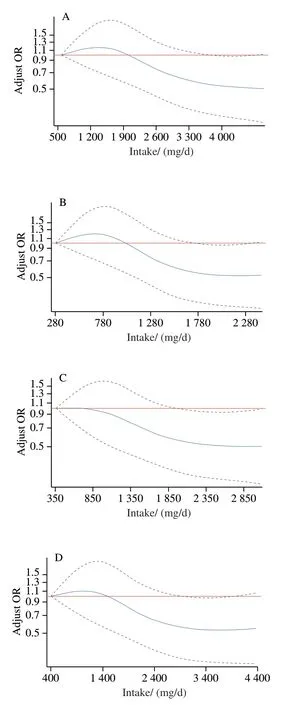
Fig.2 The cubic spline interpolation between intakes of AAAs (A),threonine (B),valine (C),lysine (D) and NAFLD.AAAs: aromatic amino acids.
4. Discussion
The present study was the first to investigate the associations between dietary individual amino acid intakes and NAFLD risk in participants aged over 65 years in China.The findings of the present study indicated that higher intakes of lysine,threonine,valine and AAAs were associated with a lower risk of NAFLD.Although nonsignificant,higher intakes of histidine,isoleucine and BCAAs were associated with a lower risk of NAFLD.
It has been reported that circulating lower AAAs and higher BCAAs levels are strongly associated with reduced NAFLD risk[28].Another research indicated higher intakes of AAAs accelerates the initiation,progress and development of NAFLD[29].In addition,a research conducted in Europe reported that participants with higher intakes of AAAs were associated with increased liver fat content and liver damage[30].Inversely,the present study showed that dietary intakes of AAAs were inversely associated with NAFLD risk.The inconsistent results may be due to differences in genetic and environmental factors between Asian and Western countries and warrant to be confirmed in additional randomized controlled trials.BCAAs are kinds of essential amino acids with a nonlinear side chain,including valine,isoleucine and leucine[31].Moreover,BCAAs supplementation showed a beneficial effect to control weight and reduce fat accumulation in the liver,finally contributing to preventing the initiation and progression of NAFLD[32,33].Although the relationship between BCAAs and NAFLD was not significant,valine and isoleucine,which belong to BCAAs,were inversely associated with NAFLD risk in present study.
A comprehensive systematic review indicated that essential amino acids could boost protein synthesis,regulate IR and improve body function,thus preventing the initiation of metabolic diseases[34].This study showed that essential amino acids,especially lysine,threonine and valine,were negatively associated with NAFLD risk.A randomized controlled trial showed that lysine supplementation could reduce some of the pathological changes associated with IR[35].To date,few population-based studies have demonstrated the relationship between threonine and valine intakes and NAFLD risk.However,animal models indicated that diet deficiency in threonine caused a variety of metabolic related diseases including NAFLD[36].In addition,an animal experiment found that valine had a positive effect on lipid balance and reduced TG accumulation in hepatocytes,contributing to NAFLD[37,38].Therefore,higher intakes of these two amino acids might be associated with reduced risk of NAFLD.As for isoleucine and histidine,current evidence suggested that isoleucine supplementation was associated with reduced accumulation of TG s and liver fat in subjects with NAFLD[39].Besides,as the precursor of histamine,histidine could accelerate the dissolution of lipids and have positive effects on metabolic syndrome[40,41].In line with previous studies,this study indicated that higher intakes of isoleucine and histidine might be associated with reduced risk of NAFLD.
IR,protein degradation,and liver fat accumulation were suggested to be the key factors of NAFLD (Fig.3)[42,43].IR was an important factor for AAAs to regulate the initiation and development of NAFLD.Epidemiological studies showed that the intakes of AAAs were positively correlated with the increase of plasma LDL-C,which was an independent risk factor for IR[44-46].In parallel,a cross-sectional study of 718 subjects indicated that AAAs was positively correlated with IR,which promoted the incidence of metabolic related diseases[26].For individual amino acids,lysine and related metabolites were found to be associated with increased levels of adiponectin,which could enhance insulin sensitivity and further ameliorate NAFLD[47,48].Besides,supplementation with lysine inhibited protein degradation to prevent the development of metabolic related diseases,including NAFLD[49].Moreover,in a case-control study,there were significantly reduced valine levels in cases compared with the controls,due to the impair of protein metabolism[50].In addition,3-hydroxyisobutyrate (3HIB),the catabolite of valine,has been identified as a key regulator in fatty acid absorption[51].Although no clinical trial reported the results of supplementation with threonine on NAFLD,animal models have shown that threonine intervention could prevent metabolic related diseases through regulating lipid metabolism and reducing fat accumulation[52].Furthermore,a study of obese adolescents with NAFLD reported that high levels of isoleucine also affect lipid metabolism and liver fat accumulation then restrain the development of NAFLD[53].In addition,two studies pointed that a higher intake of histidine was associated with reduced IR in NAFLD individuals[50,54].
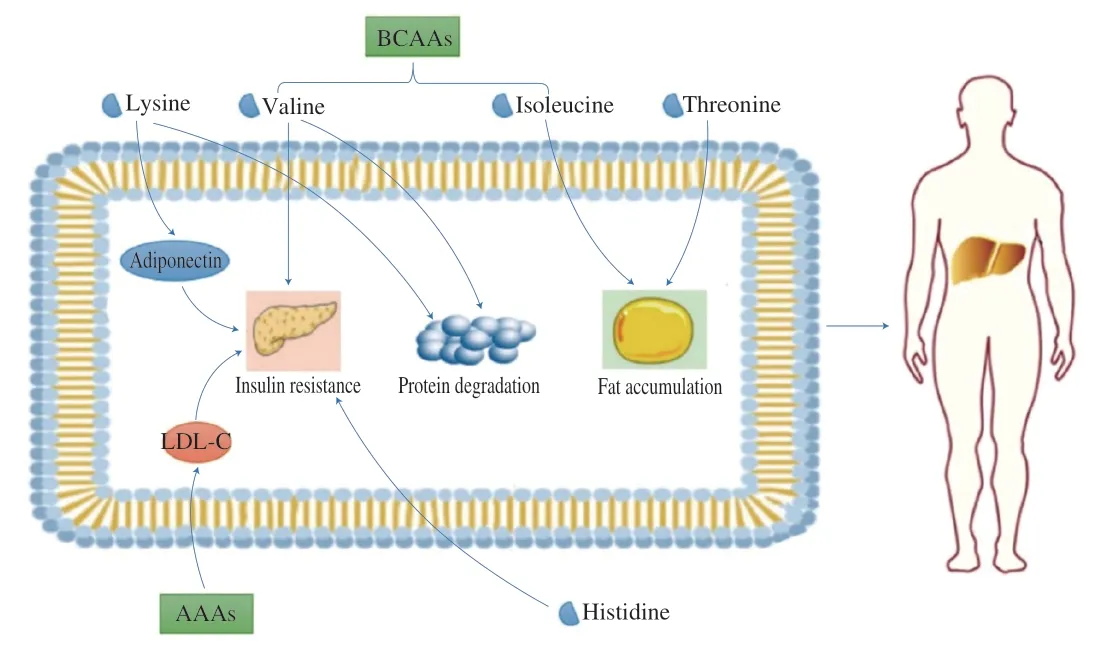
Fig.3 Proposed mechanisms of amino acids protecting NAFLD.
Sufficient dietary carbohydrate and fat intake has the function of protein sparing action and shows benefic effects on the absorption and metabolism of protein and individual amino acids[55].A recently randomized controlled trial study showed that a low-carbohydrate diet could effectively reduce body weight and body fat and improve metabolic indicators in subjects with NAFLD[56].In parallel,an upto-date clinic study indicated that a low-carbohydrate high-fat diet(ketogenic diet) was more effective in reducing steatosis and body weight in patients with NAFLD than general lifestyle advice from a hepatologist[57].In addition to the above two dietary patterns,existing studies had demonstrated that a long-term high-fat diet would lead to obesity and induce a series of metabolic related diseases,such as NAFLD[58,59].However,the present study showed that there was no significant interrelationship between carbohydrate and fat intake and NAFLD risk.Considered that the participants were over 65 years,dietary intakes of carbohydrates and fats showed to be reduced whether they are diagnosed with NAFLD or not.Therefore,the associations of carbohydrates and fats were not significant.In addition,a mounting number of studies showed increased dietary intakes of vitamins could guard against NAFLD.A clinical cross-sectional study indicated fat-soluble vitamins (vitamin A,D,and E) could ameliorate fatty liver and liver cirrhosis[60].Similarity,data of a cross-sectional study from over 210 000 participants demonstrate that participants with increased vitamin E intake had fewer NAFLD diagnoses[61].A randomized controlled trial confirmed that fish oil plus vitamin D had additional functions to ameliorate biomarkers of NAFLD[62].Besides,a research based on the China Health and Nutrition Survey(CHNS) showed a higher vitamin C intake was associated with improved liver functions[63].As for the B vitamins,a case-control study demonstrated that the controls who followed a healthy and vitamin B rich diet had a lower risk of NAFLD as compared with cases[64].Inconsistent with previous studies,intakes of vitamins were found to have no significant difference between the case and control groups,which indicated that vitamin intake was not a key risk factor for NAFLD in this study.The reason might be explained as follows.Firstly,digestion and absorption of nutrients have become difficult or could not be fully utilized with ageing.Secondly,3-day,24-h dietary records could not be obtained the precise intakes of vitamins.Thus,it was acceptable that the associations of vitamin intakes with NAFLD risk were non-significant.
Based on the above discussion,we summarized that increasing the intakes of lysine,valine and threonine were associated with the risk of NAFLD in the elderly.
Several strengths should be highlighted.To our knowledge,this study was the first to explore the relationship between amino acid intakes and NAFLD risk with a community-based case-control study over 65 years old in China.Therefore,it was more representative than hospital-based case-control studies.Simultaneously,the limitations of the present study should also be considered.Firstly,the causal inference between amino acid intake and NAFLD risk could not be obtained based on the cross-control study design.Therefore,the results were warranted to be validated in randomized controlled trials.Besides,the accuracy of dietary amino acid assessment and calculation is crucial for the component-based epidemiological approach.Considerate that the validated 3-day,24-h dietary records were detailed and investigated by a trained dietician and this case-control study was based on a large sample with adjustment for potential confounding factors,the age of the participants and imprecision of amino acid evaluation might influence the final conclusions.
5. Conclusion
The present study demonstrated that higher intakes of lysine,threonine and valine were inversely associated with NAFLD risk in senior citizens aged over 65 years.Increasing the consumption of foods which were rich in lysine,threonine and valine,including eggs,milk and deep-sea fish,might have beneficial effects to protecting against NAFLD in the elderly.Randomized controlled trials are warranted to confirm whether supplementation with these amino acids could have beneficial effects in protecting against NAFLD.
Conflict of interest
The authors declare no competing financial interest.
Acknowledgments
This work is supported by National Natural Science Foundation of China (NSFC: 82073538 and 81773433) and by the 2018 Chinese Nutrition Society (CNS) Nutrition Research Foundation-DSM Research Fund (CNS-DSM2018A30).The funders have no role in study design,data collection and analysis,decision to publish,or preparation of the manuscript.
Appendix A.Supplementary data
Supplementary data associated with this article can be found,in the online version,at http://doi.org/10.26599/FSHW.2022.9250016.
- 食品科学与人类健康(英文)的其它文章
- Modifications in aroma characteristics of ‘Merlot’ dry red wines aged in American,French and Slovakian oak barrels with different toasting degrees
- Effect of different drying methods on the amino acids,α-dicarbonyls and volatile compounds of rape bee pollen
- Dynamic changes in physicochemical property,biogenic amines content and microbial diversity during the fermentation of Sanchuan ham
- A comparison study on structure-function relationship of polysaccharides obtained from sea buckthorn berries using different methods:antioxidant and bile acid-binding capacity
- Yolk free egg substitute improves the serum phospholipid profile of mice with metabolic syndrome based on lipidomic analysis
- Underlying anti-hypertensive mechanism of the Mizuhopecten yessoensis derived peptide NCW in spontaneously hypertensive rats via widely targeted kidney metabolomics

